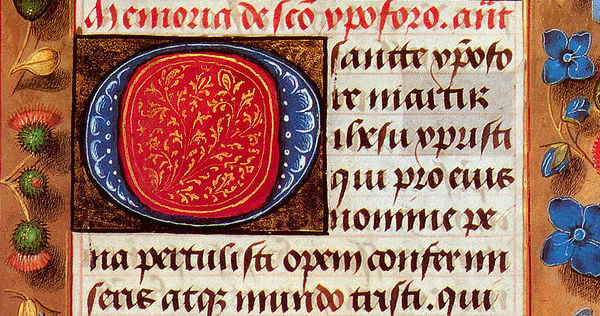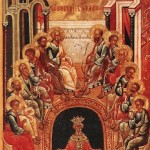
“Be very careful, then, how you live – not as unwise, but as wise, making the most of every opportunity, because the days are evil.”
It’s how Ephesians 5:15-16 went when I always came across it in the NIV. But there are other ways of translating it – for instance, both the King James and the Douay-Rheims translate the key phrase as “redeeming the time.” Now, it’s not my purpose here to get into the questions and politics of which is the more correct version or how a concept like “redeeming the time” has come in modernity to mean “making the most of every opportunity.” I shall leave this matter for other scholars and bloggers.
What I am interested in however is thinking about what it means to redeem time, and how that is different from simply making the most of every opportunity. I am also inviting you all to take advantage of our daily Facebook posts from the office as a way of participating along with us in the redemption of time.
In contrast to “making the most of every opportunity” – a seemingly haphazard and occasional project – redeeming time is something deliberate, slow, and ongoing. But to understand how it has traditionally worked, we will first have to understand a bit about monastic communities and their approach to space.
Traditionally, there are two elements in particular that are important when monastics consider space. The first is that our initial encounters with space are in a fallen world, and so there will inevitably be demons and devils there to fight with – I will leave it to each of you to decide precisely how to construe this, but I think it is fair to say that we certainly see no less evil occupying the space around us than did those who went before us, even if perhaps we are less inclined to speak about it in spiritual terms.
The second is that space – creation – is originally God’s, and it is the business of God’s servants to take it back for him. Some critics have seen in this only a masked colonialism, but if it has on occasion served colonialism, colonialism is not its primary motivating factor – indeed, part of the business of retaining space for God might indeed involve resisting particular kinds of colonialism, as happened in some Jesuit communities in South America. We shall leave the discussion of such nuances for another post, but a fine exemplar for helping us remember this approach to space is St. Guthlac, the English hermit who went out into the fens of Croyland and stayed there until he had driven out the demons and redeemed the land for God.
But as we know, space is only half the measure of reality – there is also time. And indeed one of the most important things Christians have done since the beginning of their faith is to follow their Jewish roots in maintaining a liturgical calendar and thereby sanctifying time even as the monastics sanctify space. Just as various feasts such as Passover and Purim are observed at particular times each year in Judaism, so Christians observed and continue to observe memorials, feasts, and solemnities marking days of significance in the faith. The degree to which various of these days are celebrated now among Christians will depend on how high-church or low-church they are, but even Christians of the lowest church persuasion generally celebrate days such as Good Friday, Christmas, and Easter Sunday.
Hence, even in the most congregationalist churches, there are still relics of the practice of redeeming time. But it was when I got involved in high Anglican and eventually Catholic worship that I really began to see how redeeming time works as a practice and a habit rather than something we do off the cuff with various moments.
I first encountered daily liturgical prayer in the Book of Common Prayer, Thomas Cranmer’s beautiful synthesis of the monastic prayer tradition designed for use beyond the monastery. And then my confirmation sponsor introduced me to the hours in the modern Catholic tradition.
They are a bit more complicated than the Book of Common Prayer, but what is lost in simplicity is gained in the addition of more thorough engagement with tradition and deeper participation in the communion of saints through remembrance of saints’ days. They also are more in concord with regular celebration of the Mass in a way that the BCP could never be with the more modern Book of Alternative Services that is commonly used now in most Anglican churches. But whatever your preference – and it may largely depend on your denominational affiliation – both are wonderful syntheses of a prayer tradition that has been going on since the time of the early church.
However, for the sake of brevity, I will here offer only a brief description of the Catholic liturgy of the hours, and suggest one small way we can perhaps help you begin engaging in these treasures of Christian worship. As practiced at present, the three primary periods of prayer are morning, evening, and the office, with other shorter prayer periods throughout the day. Certain traditional prayers are fixtures for various times – the song of Zechariah in the morning for instance, and the Magnificat in the evening. The office is a set of readings from Scripture and tradition, often chosen to accord with themes of the liturgical season. Finally, the psalter is absolutely central in praying the hours; the design is such that, if one prays through the hours faithfully and daily, one will have prayed the entire psalter once every four weeks.
From this brief description, you should be able to see two things. First, how the complexity and thickness of the tradition is a wonderful way of immersing oneself in a way of being in time far different from the thin and rushed habits we usually fall into in the modern world. Second, the complexity and thickness of the hours can also make it difficult for beginners to engage them. For myself, I certainly would not have done so had I not had guides, and although it is perhaps easier now with internet sites that determine all the necessary readings automatically, there is I think something uniquely edifying in learning from interaction and prayer with others rather than merely from text and on one’s own.
After all, part of the point of the hours is that, even when we pray them by ourselves, we are in fact joining an immense community of others past, present, and future who have prayed, are praying, and will have prayed along with us. So in the interest of fostering and encouraging such community around the hours, we at the Inner Room are trying an experiment for May, and this is to post daily on our Facebook wall an excerpt from one of the readings from the office.
It is not a replacement for more extensive prayer, to be sure, and shouldn’t be taken as such. But the hope is that in a small way it will remind those of you interested that part of our business as Christians in the world is to redeem time and set apart space in a world increasingly utilitarian and stingy with both. It will also be a handy reminder of what feast days, solemnities, and memorials are taking place – and I’m sure you, like me, will be pleasantly surprised to discover some you didn’t know about.
If you’d like to be part of this liturgical experiment, simply follow us on Facebook, where we will be posting daily throughout May. And if you appreciate it, let us know, and we’ll consider making it a regular feature of the Inner Room.












